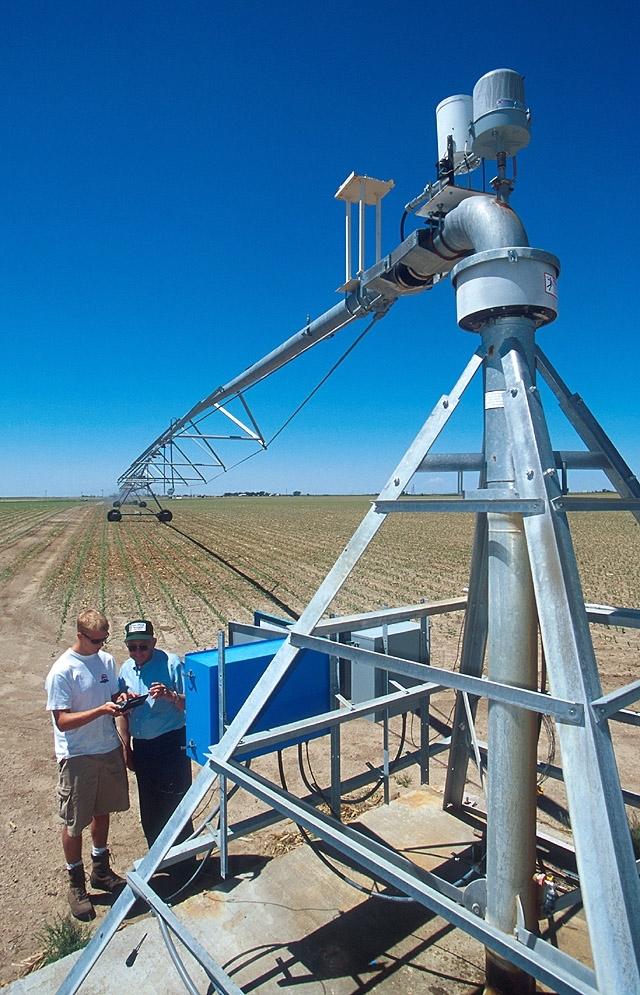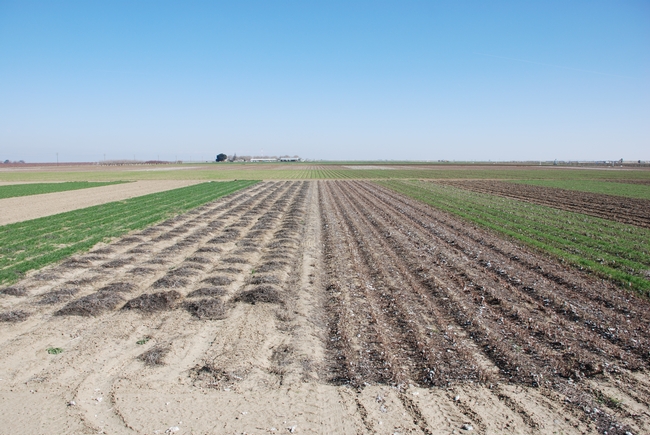- Author: Jeannette E. Warnert

Farmers and other members of the public are invited to the free event to see the system in operation and learn how overhead irrigation can be combined with no-till or minimum-till farming methods to create a more sustainable, profitable and environmentally sound agriculture industry. The field day includes a free barbecue dinner. To register, go to: http://ucanr.edu/TwilightRegistration.
Overhead irrigation systems, such as center pivot systems, are the most prevalent form of irrigation nationwide; however, they have not been widely adopted in California to date. Recent technological advances in overhead irrigation – which allows integration of irrigation with global positioning systems (GPS) and management of vast acreage from a computer or smart phone – have boosted farmers’ interest in converting from gravity-fed surface irrigation systems, which are still used on 5 million acres of California farmland.
“We see tremendous possibilities for overhead irrigation in cotton, alfalfa, corn, onions and wheat production,” said Jeff Mitchell, UC Cooperative Extension specialist in the Department of Plant Sciences at UC Davis. “There is also great potential for overhead irrigation in California’s $5 billion dairy industry for more efficiently producing feed crops like alfalfa, corn and sorghum.”
The use of the new system at the West Side Research and Extension Center, valued at about $100,000, was donated by Reinke Manufacturing of Hastings, Neb. Reinke will also sponsor the installation of its OnTrac irrigation monitoring system, which will give farmers and the public a real-time, online window of observation on crops growing and being irrigated by the new center pivot.
To begin with, the center pivot will irrigate an 8-acre half-circle of alfalfa and an 8-acre half-circle of cotton. All aspects of production – including irrigation system performance, weed control, fertilization, soil salinity and economic viability – will be monitored by a diverse team of researchers from UC Cooperative Extension, Fresno State University and UC Davis, plus farmer cooperators and industry members.
“In cotton and alfalfa, we will study deficit irrigation,” Mitchell said. “By controlling the speed of the pivot, pie-shaped segments will get either full irrigation, three-quarters of the full amount or about half of the full irrigation quantity.”
At the Sept. 13 field day, researchers will share what they have already learned about using center pivot systems in California. Participants will hear how overhead irrigation systems operate, how they are optimally managed, how soil water sensors can be used in conjunction with overhead systems and how overhead systems can result in higher application efficiencies and uniformities.
For more information, contact Jeff Mitchell, jpmitchell@ucdavis.edu, (559) 303-9689.
- Author: Jeannette E. Warnert

To introduce more valley farmers to the benefits of conservation agriculture practices, Conservation Agriculture Systems Innovation (CASI) produced a six-part documentary featuring California farmers, UC researchers and agency representatives. The series premieres Aug. 6 on the CASI website (http://CASI.ucanr.edu) with a 7-minute segment that lays out the theoretical principles and the scientific basis for conservation agriculture. Additional segments will be released each Monday for five weeks thereafter.
Throughout the series, viewers will meet farmers who are implementing conservation agriculture successfully and profitably on their Central Valley farms. The 6- to 10-minute episodes review the core principles and practices associated with conservation agriculture systems and provide examples of successful local adoption.
After the six-week series airs, viewers, farmers and others interested in conservation agriculture are invited to the UC West Side Research and Extension Center in Fresno County for the annual Twilight Conservation Agriculture Field Day, Sept. 13. The event, which begins at 4 p.m. and concludes when darkness falls, is free and includes a barbecue dinner. Viewers can get clarification on points from the video series and meet many of the farmers and scientists featured in the documentary, plus get a first-hand look at conservation agriculture research currently underway. To register for the Twilight Field Day go to http://ucanr.edu/TwilightRegistration. The West Side Research and Extension Center is at 17353 W. Oakland Ave., Five Points.
“Our goal with the video series is to reach a wider audience of farmers with our research results and on-farm success stories, which show conservation agricultural practices can help make farmers more competitive and sustainable in the long run,” said Jeff Mitchell, UC Cooperative Extension specialist in the Department of Plant Sciences at UC Davis.
The Conservation Agriculture Systems Innovation documentary series includes the following episodes:
Aug. 6: “Introduction to conservation agriculture” – The first video defines conservation agriculture and outlines its increasing credibility in the global context.
Aug. 13: “Maintaining crop residues” – California farmers have tended to adopt “clean cultivation” systems, but research has shown that maintenance of residues from the previous crop or a winter cover crop helps improve soil and reduces evaporation from the surface.
Aug. 20: “Conservation agriculture in tomato production systems” – These systems cut production costs, reduce dust emissions and store more carbon in the soil.
Aug. 27: “Conservation agriculture in dairy silage production systems” – Three dairy farmers committed to conservation agriculture systems in their silage production share their secrets and success.
Sep. 3: “Minimum tillage systems” – This video features examples of a number of reduced pass or ‘pass combining’ tillage systems that have been developed during the past decade.
Sep. 10: “Coupling conservation tillage with overhead irrigation” – Overhead irrigation systems, such as center pivots, are particularly useful when coupled with conservation tillage.
For more information, contact Mitchell at (559) 303-9689, jpmitchell@ucdavis.edu.
Even on the west side of the San Joaquin Valley, where average rainfall is a mere 7 inches per year, farmers can reap the benefits of winter cover crops without the expense of irrigation, University of California research has found. Growing a winter cover crop helps retain soil nitrogen – keeping it from leaching into groundwater – improves water infiltration, reduces runoff, increases soil organic matter and boosts long-term soil fertility.
Moreover, a vigorously growing cover crop can smother winter weeds, reducing or eliminating the need for herbicides or tillage between crops.
“Despite the many and varied benefits of cover cropping that are increasingly seen by farmers in other parts of the country, the vast majority of Central Valley farmers currently do not use them,” said Jeff Mitchell, UC Cooperative Extension specialist in the Department of Plant Sciences at UC Davis. Mitchell, a cropping systems expert, is based at the Kearney Agricultural Research and Extension Center in Parlier, Calif.
The costs and benefits of winter cover crops are being examined in an ongoing trial at the UC West Side Research and Extension Center in Five Points, Calif. Initiated in 2000, the trial is led by Mitchell, William Horwath, a professor in the Department of Land, Air and Water Resources at UC Davis, and Dan Munk, UC Cooperative Extension advisor in Fresno County, a cotton and soils expert.
Mitchell said the West Side trial addresses valley farmers’ primary concern about cover crops – water.
“When water is short, as it has been in many recent years, farmers wonder how inserting an extra crop that doesn’t bring an immediate return on investment makes sense,” Mitchell said. “But our work over the last 12 years has demonstrated that cover cropping ‘on the cheap’ – relying only on rainfall for irrigation – supplies many benefits and doesn’t cost much.”
Rainfall during the November to March winter growth period in Five Points averages 7 inches, slightly less than the 30-year average annual rainfall of 7.6 inches for the site. Winter rainfall has varied considerably during the trial, from a low of 2.9 inches in 2003 to a high of 11 inches in 2006.
From 2000 to 2010, a cover crop mix of triticale, ryegrain and pea was grown at a seed cost of $55 per acre (2012 dollars). In 2011 and 2012, the researchers used a mixture of fava bean and “tillage radish” for the cover crop, at a cost of $50 per acre.
Tillage radish is a large-rooted winter annual being marketed for its ability to improve soil condition. It’s thick, tuberous roots break up the soil surface. When it is killed in the spring and the roots decompose and shrivel, it leaves behind channels that help with aeration and water infiltration.
Over the course of the UC trial, an average of 3,400 pounds of dry biomass per acre was produced by the cover crops each year with rainfall alone. Productivity generally related to the amount of rain, with as little as 65 pounds of dry biomass per acre in 2007, when rainfall was 5.2 inches, and 6,400 pounds in 2005, when 10.1 inches of rain fell.
The timing of rainfall was also important. Rain is needed early to establish the crop and late in the season to sustain its growth when the temperature warms.
Over time, growing cover crops results in a significantly higher amount of carbon in the top foot of soil. Following eight years of cover cropping, soil carbon values in the standard tillage cover crop system, in which the cover crop was treated as a green manure and incorporated into the soil at a depth of 10 inches, was 12.2 tons of carbon per acre. Where cover crops were combined with conservation tillage, the researchers measured 12.8 tons per acre. In areas managed with conservation tillage and no cover crop, 11.7 tons per acre of carbon was in the top foot of soil. Under standard tillage and no cover crops, currently the common practice in the San Joaquin Valley, soil carbon came in at 9.9 tons per acre.
In addition to improving soil quality, farmers are investigating whether storing extra carbon in the soil will make them eligible for selling carbon credits under California Assembly Bill 32, the Global Warming Solutions Act.
“Sequestering carbon in farmland could be a means of mitigating global warming from greenhouse gas emissions,” Mitchell said. “We are working with farmers to develop a record of performance so they can document their potential for storing more carbon using conservation tillage and cover crops.”



